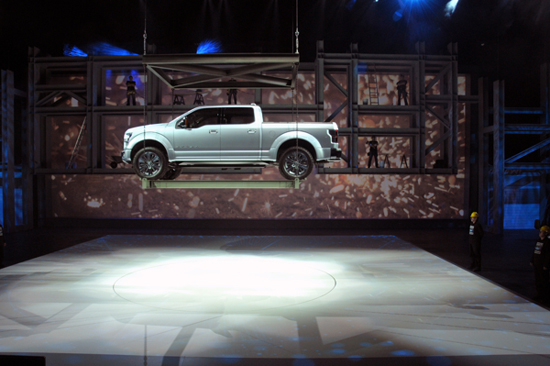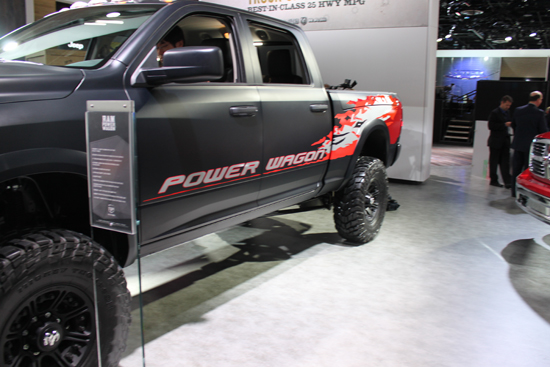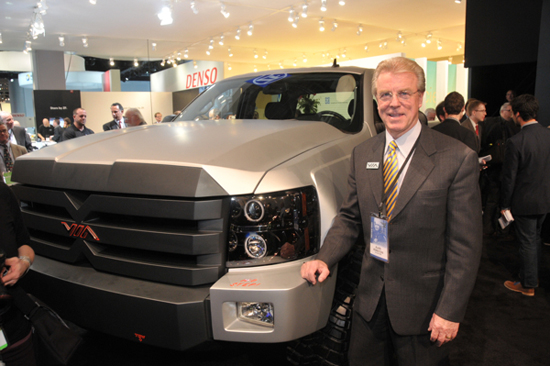2013 NAIAS Full-Size Truck Wrap – Bright Future?
Tim Esterdahl | Jan 16, 2013 | Comments 7
After two days of attending the media preview days at the 2013 North America International Auto Show in Detroit, MI, here are some final thoughts. In short, differences in models are closing, gas-powered only engines is shrinking and some automakers don’t seem to care about the full-size truck market.

Final thoughts and commentary on 2013 NAIAS show.
Fuel
The future of gas-only vehicles is very much in question. Every manufacture was proudly showing off some sort of electric hybrid vehicle and that included luxury vehicles as well. There were several really cool luxury electric coupes, SUVs and the X-Trux from VIA motors.
When it comes to electric everybody was making a case for their future with the following statements:
- Total Cost of Ownership is key to understanding cost benefit analysis. Yes, you will pay a larger car payment, yet when you add up your current expenditures on gas and maintenance, the electric vehicle is cheaper each month.
- No Range Anxiety. Automakers were very clear in saying that people who shy away from electric hybrids due to range anxiety simply don’t know how electric vehicles will work. Yes, there are a few concepts that are all electric, however, the majority of the ones I saw were hybrids. Let me be clear, the electric hybrid is were automakers are taking us. The electric-only concepts will stay concepts.
- To the point, consumers need to get educated. Electric vehicles are the future and fighting it is foolish.
State of Full-Size Market
As I stood back and looked at all the offerings at the show, it became clear that everyone had a different idea on which way to go. Some really showed off their full-size trucks while others didn’t bother showing any.
Ford had a TON of trucks and had an impressive display. They really stressed the EcoBoost engine, reinforced frame and towing/work capabilities.

The Ford Atlas lowed to the Joe Louis Arena floor.
Also, impressive was the Ford Atlas concept launch that was held in Joe Louis Arena adjacent to Cobo Center. This truck stole a lot of the spotlight from the GM twins on day 2, but didn’t diminish their spotlight at all on day 1. If Ford had really planned to do this, they would have had a day 1 unveiling.
It seems Ford gets the truck market. In a press release they reiterated their view:
…Ford emphasized its expanding global footprint in commercial work vehicles including medium-sized trucks, vans, pickup trucks and buses. Such vehicles are “often overlooked, but they provide strong growth potential,” Ford CEO Alan Mulally said.
While this may sound great to truck guys, one does wonder about Ford’s long-term profitably when focusing on one part of the market. Also, they don’t seem that concerned about the drivers who buy trucks to haul around the family. Look they will probably continue to dominate fleet sales and commercial, but it is questionable how many they will sell elsewhere.
Editor’s note: Ford’s Mike Levine (@mrlevine) tweeted at me to point out that Ford sells the SuperCrew, and very successfully. I think Tim’s point in the paragraph above was that Ford can’t overlook the importance of family trucks going forward, however, if that wasn’t his point (or if that point wasn’t clear), let it be known far and wide that Ford *does* sell trucks for families and they are concerned about that use. We just aren’t sure about the wisdom of having a focus on commercial business first.
Dodge had a lot fewer trucks, but really played up the awards they have won. This was especially true in being named North American Truck of the Year. The Execs were visibly relieved to have won.
Their displays were highlighted with awards and towing capacity. They also really tried to show how the bed boxes don’t take away room from the bed with a lumber display. In addition, they had a really cool “guts” display showing the truck without the cab/body.

This Dodge Power Wagon sure looks bad ass, but what purpose does it serve?
They also brought a pretty impressive looking crew cab Power Wagon. It was a cool looking ride (albeit really hard for me to get into), but many people looking at it really questioned how useful it was. Talking with an off-roader who spends a lot of time in Michigan, he just shook his head. There is no way that truck can go down any trail, it’s only use is in a wide open area like sand dunes. His question, “Why would someone buy a stock off-road truck for only one type of trail?” The Ford Raptor has a similar critic.
GM had several new trucks on the floor and spread out the Sierra from the Silverado. They stressed the new EcoTech motors and interior upgrades with two interior displays showing just the cab. They also had an interesting “museum-like” display of their instrument panel and doors (?). This was good, because the GM trucks were the only trucks on the floor that were locked and I couldn’t get into.

You think GM is proud of their instrument panel? Yet, it seems all these panels are starting to look the same.
The product Reps were really talking up the engine, aerodynamic modifications of the body style and instrument panel. They shied away from any real discussion on why they didn’t do a lot to upgrade any other components. Many in the media feel like GM really just upgraded an old truck without really striving for any big improvements. While the new engines are sexy looking and completely new according to the Rep, they are really just old engines refurbished.
Talking with the Rep about the lack of the “wow” factor, he conceded that looking at the truck, you don’t see it. His thought was that the “wow” factor would be in the details MPG, towing, weight and HP. And no, those numbers aren’t coming out anytime soon from what I heard.
Toyota only had the Tundra that towed the space shuttle. They focused their display on concept cars and didn’t even bring a Tacoma at all. It seemed to me that they were trying to avoid all the hoopla GM and Ford were creating by waiting until Chicago to do their unveiling. Time will tell if that strategy pays off.
Honda and Nissan didn’t even bother to bring any trucks. It was interesting to hear a Jose Munoz, senior vice president for sales and marketing at Nissan Americas, talk about trucks at a media round table.
“We understand that it is very important” to remain in the segment, Munoz said, according to PickupTrucks.com. “Full-size is where the potential is.”
And yet, they didn’t bring a single truck to the Auto Show. If the North American market is the supposed home to highly profitable full-size trucks and Detroit is the “largest” stage, why didn’t they bring any? Very curious.

We will have more on this X-Trux soon. I asked where the rocket launchers were.
VIA Motors had a really nice demonstration of their technology and I was able to speak with their sales guy and engineer. This will be in a future article. It is an interesting idea that could push other automakers to look at their technology. However, I overheard a few guys saying VIA motors is really a niche market and will have little real-world impact.
As the media days wrap-up, it was clear to me that the automakers aren’t focused on really improving full-size trucks. Instead, they are tweaking and expanding on similar ideas: direct injection, aerodynamics and dropping weight. Instead they are spending all their time and energy on passenger cars. Unless one of them rocks that boat, the real, low energy in the segment will leave people wanting for more.
Related Posts:
Filed Under: Auto News


It saddens me that this whole chase-the-MPGs mindset of the ‘environmentally conscious’ has infiltrated the federal government to such an extent that it (the government) has significantly stifled capitalism in the automotive industry. There are plenty of folks who are willing to buy eco-friendly vehicles, that government regulation of this sphere is unnecessary. I feel as though I’ve been criminalized for wanting a big, heavy, powerful, grunt of a truck as my daily driver (although during the week, I drive all of five minutes to a local commuter rail train station for my commute into ‘town’ for work – do I get any credit points for that?).
Why should I have to “get educated” because “electrio vehicles are the future and fighting it is foolish”? The ‘nanny state’ is already trying to take away my guns. Why should I let it take away my full-sized truck? If (fossil) fuel price/availability is their concern, then maybe the government should rely less on foreign oil and let us drill the vast amount of domestic (North American) deposits. If air pollution is their concern, I say it’s unwarranted, especially considering the considerable (voluntary) consumer shift from “gas guzzlers” to hybrids and EVs, which I am sure has slowed, if not reversed the growth in vehicle exhaust as an air pollution contributor.
OK. Rant over. Whew – I needed that.
Feel better?! LOL.
-Tim
Sorry. I just had one of those ‘moments’.
I can see how you would think the Feds are behind the growth in EV vehicles. I’m not 100 percent sold myself on that idea. The automakers I talked through said that now the consumer demand is driving that market with Govt assistance. Granted without Govt rebates the EC market would be less, I’m not sure you can put all the growth under there “nanny ism.”
Tim
My perspective is that it’s not so much the government directly driving the growth in EV vehicles, but rather the government regulations mandating increased MPGs while simultaneously promoting (with my tax dollars) ‘clean’ energy. That direct regualtory involvement forces the automakers to come up with alternative powerplants/drivetrains to satisfy the MPG thresholds. I am certainly not against hybrids/EVs, I just don’t want to be told that I eventually will be forced to buy one.
Big Ford display, They really stressed the EcoBoost engine, reinforced frame and towing/work capabilities. Now the Big sign says “ARE YOU WITHIN “J” STANDARDS?” Well I guess your towing is all hype……….
I too would like to see 22 avg. hwy. mpg but doubt it will happen unless the tundra decreases the power output some which no one wants. Personally, if the new tundra can deliver 21 avg. hwy mpg and yet achieve same power numbers, it is good enough for me as long as the don’t screw up the exterior or interior too much.